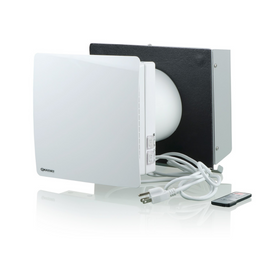
Affordability meets Sustainability in this Colorado Home
Last Updated: Feb 13, 2025Karen Hoskin is multi-hyphenate with a mission. As an entrepreneur, the founder and owner of a distillery, sustainability thought leader and speaker, and a zero-waste advocate she holistically blends business and pleasure around a life-long passion for environmental stewardship.
Table of Contents
- Phase One: Bringing Sustainability Home
- Upside Down Living
- Life in Balance

She started her craft distillery, Montanya Distillers, in 2008. The Certified B-Corp, she says, is driven by a philosophy of stewardship. According to the website, every business decision is guided by questions like: “Are we taking care of the people involved? Are we taking care of the environment and the greater community around the company? Are we leaving a mess for someone else to clean up later? Do we feel pride in what we are creating and how it is created?”
Hoskin also co-founded Zoetica in late 2017. The social entrepreneurship company creates zero-waste kits for travel, everyday use (picnics and lunches), and hauling groceries; the kits help people reduce their use of single-use plastics and other materials that routinely end up in the trash.
As the sustainability correspondent for Distiller Magazine, she’s written on “Ten Ways I Freed My Distillery From Environmental Irresponsibility”; how her business practices are all about “Taking Sustainability Deep”; and how she’s reducing the garbage pileups during tastings and “Ditching Trashy Events: Five Steps.” As a speaker, she travels widely to talk about her zero-waste experiences and sustainability practices.
Is it any surprise, then, that Hoskin would build a home that's much more sustainable than the average? Now that Hoskin and her husband Brice are empty nesters (their boys are now in college), they decided to settle down in Crested Butte, Colorado, where they have their businesses. (Brice is a former journalist and editor, inventor and entrepreneur, and founded Mountain Boy Sledworks, which created hand-crafted sleds.)
“Sustainability is how I make every decision in life,” she says, from the large-scale business choices she ponders to “what food I buy, to my clothes to shoes, to my vehicle. I always ask: What’s the impact of what I’m doing and how sustainable is it, and what’s its durability? Because I’m aware if I don’t apply that to my own everyday life, I can’t expect anyone else to apply it to their lives.”

Phase One: Bringing Sustainability Home
“Crested Butte is a costly place to live,” Hoskin says. She and her husband lived in an apartment for several years as they established themselves and their businesses in the community. Then, Hoskin entered a drawing for a “workforce lot.”
The city had set aside deed-restricted properties downtown for people who live and work year-round in the community, she explains. She won and was able to buy a lot. “It’s amazing,” she says. “I literally won the lottery the way most people think of the lottery.”
The lot came with a maximum build price based on the lot’s square footage and the proposed number of bedrooms in the new home. “We’re limited to $400,000,” she says, “which sounds colossal. But the price of an average house in Crested Butte is $1.4 million.”
In July 2019, the Hoskins began building their 1,300-square-foot home. “We’ve been working with [architect] Andrew Hadley, who has built a lot of large vacation homes, and it’s not his mindset. He’s excited to be working with us. He’s never had the luxury of designing a house that didn’t have at least two bathrooms in it,” she adds with a laugh.
Phase one of their home is complete. They framed with FSC certified wood, “with some traditional wood mixed in there,” she says. “For me, one of the big questions was: If we’re going to frame a house with wood (and prohibitively expensive steel), which sustainable and environmentally responsible products will meet our rigid building codes related to snow load and wind. We’re at 9,000 feet in the Rockies.”
They super-insulated the structure using a zip system as specified in the LEED version 4. “It’s a system that goes around the framing before you put in the insulation,” she explains. “It creates a single, highly rigid, highly energy-efficient building envelope.” Within the zip system, they used cellulose insulation made of recycled newspapers.
Phase one also included installing high-efficiency Anderson windows, sheathing the standing metal-seam roof, and adding a porch on the west side. The garage was framed and roofed. Wood from the region’s bark-beetle kill will be used for the home’s exterior, along with HardiePlank. They saved all trimmed non-engineered wood and will find ways in which to reuse it.

Upside Down Living
The Hoskins’ lot doesn’t have any trees, which allows for “enormous passive solar [potential],” she says, especially on the second level. To maximize cozy mountain living in the winter, the living, dining, and kitchen areas are on the second level. “The bedrooms are on the first level, so we’re living upside down,” she says.
The home’s interior will include bamboo floors and whole-wood cabinetry and built-ins free of toxic glues, formaldehyde, and various volatile organic compounds. VOC-free paint, low-flow plumbing fixtures, and LED lighting will be installed throughout the home.
The couple has also been scouting and collecting castoffs from large vacation homes built in the area: a kitchen sink, beautiful tile, and skirting for the home’s exterior that would have otherwise gone into dumpsters.
All of their appliances will be high energy star rated. Heat and hot water will be produced using an on-demand water heating system. “We won’t be constantly heating any water or glycol for in-floor heat when it is not in use, which is an amazing adaption in energy efficiency,” she says.
Until they install solar, the Hoskins are buying wind power from third-party partners. “We still have some calculations to do to determine how much solar we need, as we have a north-south facing lot,” she explains. “But because we’ll be installing solar on the west-facing roof, we’ll be able to generate plenty of electricity.”
Life in Balance
“I’m working hard to balance building an affordable house with sustainability, which has been the biggest challenge of all,” she says. Managing the home’s mountain-modern farmhouse design and construction “has the potential to be the straw that broke the camel’s back,” she adds.
“But it’s also an opportunity that may not come to us again. We own three businesses, employ 30 people, and have never owned a house here because we couldn’t afford it. It’s now or never if we want to stay in our community. Plus, we’ve always wanted to live in town. My zero-waste model is to ride a bike as much as possible. I’ve cut my vehicle miles in the last five years by 75 percent.”
Living in a more sustainable home will mean “We’re walking the walk,” she adds. “I feel strongly about mindfully incorporating social responsibility, environmental stewardship, and sustainability in everything I do. I don’t want to be telling some crazy story about how cool it would be IF we do this or that. I want to model that behavior for others.”
Camille LeFevre
Camille LeFevre is an architecture and design writer based in the Twin Cities.










